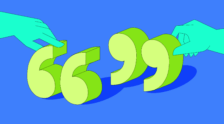
Imagine starting every day with a positive mindset and can-do attitude. Rather than pulling the covers over your head and retreading yesterday’s problems, you focus on the good things ahead. Of course, unrelenting positivity isn’t realistic or always helpful, but there is a tool that can elicit greater happiness and optimism in your daily approach to life: the gratitude journal.
A gratitude journal is not the same thing as a diary. Instead it’s a tool for focusing on the things you’re grateful for. While we stand behind all of the ways diaries can improve your life, this is something different. In this post, we’ll explore why gratitude journals are such an effective tool for mental health, how to begin keeping one, and offer example entries to get you started!
What is a gratitude journal?
A gratitude journal is a tool to keep track of all the good things in your life. It’s a personal practice where you write down things you are grateful for on a regular basis.
Keeping a gratitude journal takes only a few minutes for each entry, but the mood-boosting effects can be felt all day. This is because there are countless benefits to practicing gratitude, backed up by research, including:
- Greater empathy for others
- Increased personal fulfillment or joy
- Better sleep
- Lowered symptoms of physical and emotional pain
- Faster progress toward personal goals
In a gratitude journal, you write down specific things, events, or experiences that you are thankful for. These can include simple pleasures like a great cup of coffee or good book or significant life events like receiving a job promotion or making a new friend. You can also write about people you appreciate, acts of kindness you received, small moments of joy, or anything else that brought positivity to your day.
Your gratitude journal is for your eyes only, so you’re free to write your thoughts without worrying about the perceptions of others. Think of your gratitude journal as a tool to help you gain clarity on what really matters and what you truly appreciate.
What is the purpose of a gratitude journal?
The main purpose of keeping a gratitude journal is to nurture an attitude of gratitude and shift focus away from negative thoughts.
In our daily routines, it’s easy to get caught up in whatever is causing you stress. By writing down all of the things you’re grateful for in a dedicated place, you can counter this negativity and focus on progress, achievements, and things that make you happy instead.
For many, keeping a gratitude journal serves several purposes:
- Enhance mindfulness: Gratitude journals are known to promote mindfulness, which is the practice of being present in the moment with nonjudgmental awareness. Writing about what you’re thankful for encourages you to be fully present and acknowledge the positive aspects of your life.
- Promote self-reflection: Reflecting on and writing down things that you’re grateful for can lead to greater self-awareness. Gratitude journals encourage you to take stock of your life, appreciate the good things that you have, and gain perspective on what truly matters to you.
- Boost well-being: Studies have shown that practicing gratitude can have a positive impact on your mental, emotional, and even physical wellness. Keeping a gratitude journal has also been linked to reduced stress levels, improved sleep, and greater satisfaction with life in general.
How to keep a gratitude journal
Everyone’s gratitude journal will look a little bit different and can take on various formats, such as a notebook, an online document, or a dedicated app. Whatever format you choose, make sure it’s one that’s easy to stick to.
Here are three steps to help you get started in keeping your very own gratitude journal:
1 Choose a format
The first (and simplest) step to starting your journaling practice is to choose the right journal for you. As we already noted, the format is entirely up to you and can be a physical journal or something stored on your phone or computer.
2 Set aside time
Choose a time that works for you to write in your gratitude journal each day or several times per week. The only way to maintain this practice is to make it a habit. Try attaching it to an existing habit, like your nightly wind-down routine or your morning coffee, so it becomes second nature—and not a chore.
3 Start with prompts
Blank pages are always daunting, so why not make it easy on yourself and rely on some prompts to get the gratitude flowing? Here are a few:
- What are you most looking forward to this month?
- What is something that makes you unique?
- Write about something you have now that you didn’t have one year ago.
- If you had to give up all of your possessions but two, which two would you keep?
- List five things that made you smile this week.
Gratitude journal examples
The key to a successful journal entry is to fill it with detailed imagery. Use your five senses to describe what you’re grateful for—down to the very smell and texture of those delightful homemade cookies your colleague brought to work today!
If you’re still unsure how to kick off your gratitude journal, here are some examples of gratitude journal entries that can offer some inspiration:
- I’m grateful for the delicious meal I had at my favorite restaurant last weekend with Martín. All of the flavors were mouthwatering, and the artistic yet simple presentation was photo-worthy. It was so special to share the food with such great company.
- Today my manager gave me kind and effective feedback on my latest project at work. It motivated me to keep pushing toward my goals and made me feel like I am a crucial part of the team.
- This week, I am grateful for the unexpected phone call from my friend Jia, whom I hadn’t heard from in years. It was so nice to reconnect, and it reminded me of how thankful I am for all of the friendships that aren’t always at the forefront of my mind.
Start where you are
Gratitude journals are a seriously powerful tool for self-care, self-reflection, and personal growth. The key is to start where you are. Don’t waste time looking to the past for examples of things or memories you appreciate. Rather, spend time getting to know yourself today, focusing on all the good things that are right in front of you. Gratitude can be self-perpetuating and can act as a beacon to bring more positivity your way.






